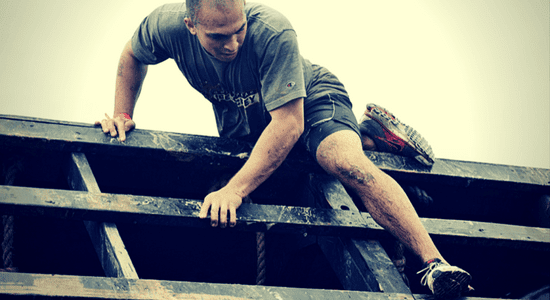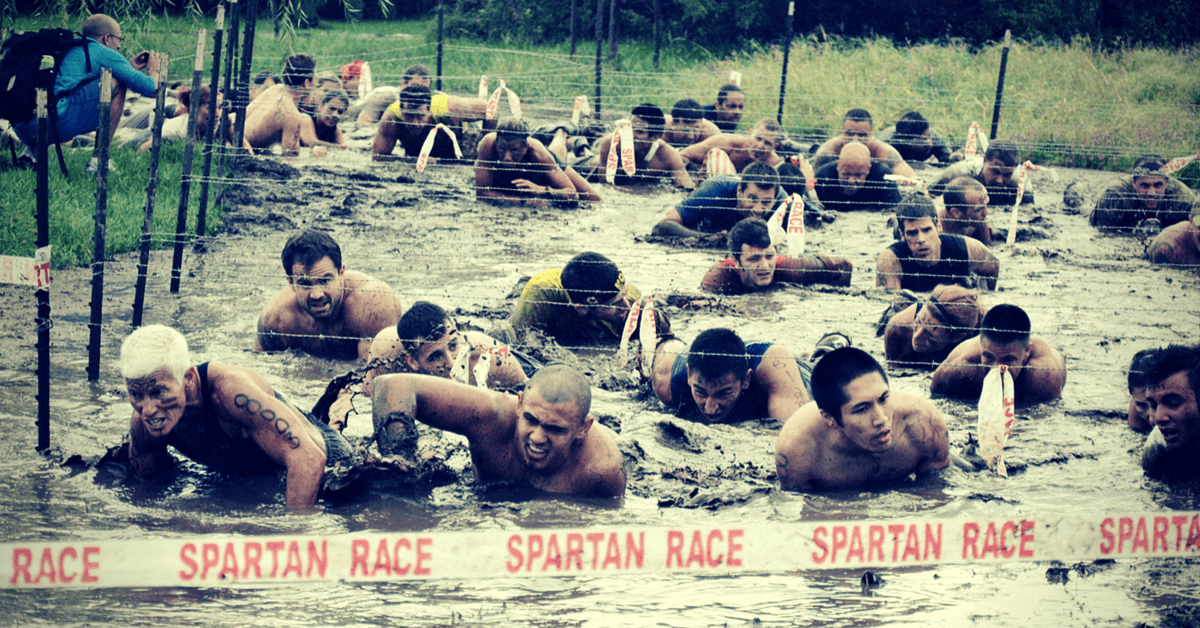Running events like Tough Mudders, Spartan Races, and obstacle-type races have become extremely popular in recent years for fitness first-timers and seasoned warriors alike. It’s likely to get a client who wants to get into running and race shape for one of these events.
But is your client actually ready to race?
If your client is like most of the first timers I meet when they walk through my doors, probably not. Starting running isn’t as easy as lacing up some sneakers and heading out the door. There’s training, ideally a running program, involved. So if your client wants to run pain-free and crush the competition, here’s what you need to know to help them.
Most running programs are actually terrible
The truth is, most running programs your clients find on the internet are terrible. They make a few false assumptions and get people injured. They assume that everyone comes upon the program with a clean bill of health. Most people assume “good health” means that they have no heart or lung problems. However, they’re missing one vital aspect of the equation: the rest of the body.
If your client has done nothing but sit at a desk for years and moved little, your client is definitely not going to be ready to run until you can help them get these kinks out of their body. Something as simple as the amount of ankle dorsiflexion your client has can make tremendous differences to their running.
Try this test with your client
Place one foot flat on the ground and push their knee as far forward as they can until the heel is just about to come off the ground. Make sure to push the knee out to be in line with the little toe, not over their big toe or inside of their foot. Measure how far forward your client’s knee has moved. If it’s less than 4 inches or 10 centimeters, there is a deficiency present. It’s even worse if you’ve got a significant difference between your client’s left and right foot.
This is a big deal because since your client lacks adequate movement at the ankle, their body needs to find that extra range somewhere else. Maybe it’s in their toes, foot, knee, or lower back. Eventually, somewhere along the line, your client’s body needs to create extra inches of movement that they don’t have in their ankles. And at 1,200 to 1,500 steps per kilometer, that can add up to a massive accumulation of potentially damaging movement being created in the wrong place.
As you can see, there are many more considerations than simply your client’s heart health. To ease them into running, there are three distinct phases you must help your client through. Also, note that the older your client and the less experience they have with running, the longer you’ll need to spend on each of these stages.
Running stage one: Walk/run intervals
Stage one actually has two parts. The first part is to get a Functional Movement Screen and begin getting the body to a solid starting point while simultaneously building form. Because everybody is individual I will not go into what you may need as far as corrective exercise goes. I will, however, talk about the process to start running.

As a side note, I don’t believe in any of the popular running methods, like POSE, Chi, or any other similar style. There is no evidence that people who run with those methods suffer any fewer injuries, or go faster. There are, however, some basic guidelines to form that everyone should take note of, and this article by Tony Benson remains the best I’ve seen on the topic. You can also check out my book Run Strong, which includes details on safe practices, injury prevention, which shoes to choose, and structuring training plans.
Unlike most other running coaches, Benson has been there with the best, both in competing with and coaching athletes at the top level. Encourage your client to focus on the points outlined in Benson’s post and resist the urge to zone out (no music either, as I find it is distracting for the same reason). Every single step should be an effort to make the next step better than the one before it.
Let me pose a quick analogy: If your client were a beginner in the gym, you would not load up maximum weight straight away. Along the same vein, it would not make sense to tell people who want to start running to do sprints. That’s the single, most stupid piece of popular fitness advice. Running fast puts an enormous strain on the body--far more than a heavy squat or deadlift session ever could--with loads of up to eight times body weight. Compare that to a “heavy” squat session for a beginner (which probably wouldn’t have a load equal to body weight on the bar), and you could see how damaging sprinting could be to a beginner’s poorly aligned body.
Instead, develop:
* mobility
* stability
* proprioception
* endurance
--In that order--and finally, add strength and power. You can build mobility and stability concurrently while teaching your client how to run at the same time. The best way to do this is a walk/run program.
I like to begin with sets of five minutes. The first stage is 30 minutes total: jog one minute and walk four; repeat six times. Have your beginner client perform this three times per week.
Week 1 – Jog 1/Walk 4 x 6
Week 2 – Jog 2/Walk 3 x 6
Week 3 – Jog 3/Walk 2 x 6
Week 4 – Jog 4/Walk 1 x 6
Now we start adding time to the intervals and push that out to 10 minutes, to 40 minutes:
Week 5 – Jog 6/ Walk 4 x 4
Week 6 – Jog 7/ Walk 3 x 4
Week 7 – Jog 8/ Walk 2 x 4
Increase interval time again, to 45 minutes:
Week 8 – Jog 12/Walk 3 x 3
Week 9 – Jog 13/Walk 2 x 3
Week 10 – Jog 14/Walk 1 x 3
Increase interval time again. You’ll notice we’ve gone from 30 minutes total time to forty to forty-five minutes. Now we extend out to an hour of total time.
Week 11 – Jog 17/Walk 3 x 3
Week 12 – Jog 19/Walk 1 x 3
Week 13 – Jog 60 mins
That gets us to the end of stage one. While it may seem like it’s a long way, trust me when I say that if your client is taking up running later in life (and sorry to say, but that is age 35 and onward) this will be an injury-free way to get them to running non-stop for an hour. The injury issues can be compounded more if they are either overweight or carrying a high amount of muscle. Tell your client to take their time getting through stage one.
Running stage two: Build strength, endurance, and stability
This stage is simple. Now your client might be running an hour and they need to get to the point where they can run an hour twice a week, with a longer run of 90-120 minutes on another day. This is one of those “you just have to trust me, I’m a running coach” things. Once your client does these weekly for a few months, it’ll be easier to understand.

The mid-week runs are to easy, nasal-breathing runs. The weekend run is easy as well, but running the last 20 to 30 minutes is a little bit harder. At this point, intensity is limited. In gym terms, you’re still in the three sets of 10 phase, where your client needs easy volume to further hone form and build their body. We still need a solid bed of strength endurance before adding intensity.
The most important thing about running distance is that you can maintain midline stability and foot and ankle control for periods of time. The stabilizing muscles of the body are all slow-twitch and need to be trained that way. As well, attachments take a long time to adapt, so this is still part of our “breaking in” process. I would urge your client to stick to this phase for six months. For this reason, this makes an ideal winter preparation period for a summer event.
Running stage three: Speed work
Now we’re ready to get serious and add some speed work. Don’t let your client just go run 400-meter intervals. The purpose of speed work is not to run flat out, but to teach the body to run at a slightly higher pace than what it can right now. Most people do not ever get faster; they simply run further. In other words, their 5K time is half of the 10K time, which is only marginally faster than their half-marathon time. The goal of a speed session is to do some quality work at higher-than-target race pace.
I like to use only one quality session per week for most people. At this stage, we’re up to four runs per week: two 45-60-minute easy runs, one longer run of 120 minutes with last 30 minutes hard, and now, an interval or hill session. Here’s how both of those work:
Intervals:
1-2 kilometer warm-up, including five sets of 100-meter faster efforts, building up through each
3-5 one-kilometer efforts at above race pace, with 1-2 minutes of easy jogging in between.
1-2 kilometer cool-down
Hills:
Find a slight hill of 2-4% grade. It’s important to not just let your clients go find the steepest hill.
Warm up with 1-2 kilometers.
Run up the hill for 500 meters at above race pace and run down the hill at below race pace. The average of those speeds for both up and down the hill would be equal to your goal race pace. Do 3-5 reps.
1-2 kilometer cool-down.
It’s a slow process and may take a year just to get to the third stage, but trust me when I say your client will be injury-free and enjoying running. Not only that, but they will likely be covering a half marathon every weekend during their long run, so longer events like Tough Mudder or Spartan Race won’t pose a problem. Don’t be in a rush, as that way leads to the doctor’s office.
This blog post originally appeared on readpt.com. It has been reposted here on The PTDC with permission.
Photo Credit: Featured image by Edwin Martinez, Image 1 by Edwin Martinez, Image 2 by Pexels images









